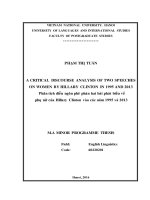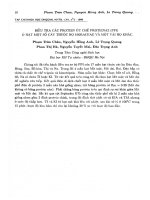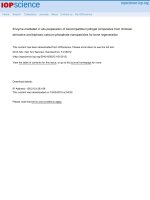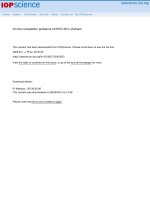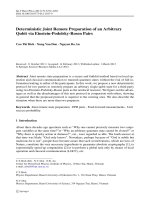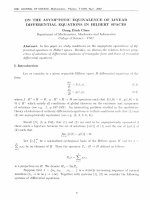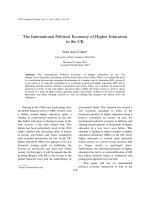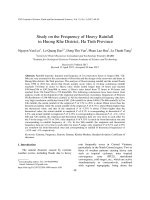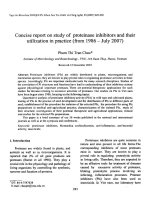DSpace at VNU: Enzyme-mediated in situ preparation of biocompatible hydrogel composites from chitosan derivative and biphasic calcium phosphate nanoparticles for bone regeneration
Bạn đang xem bản rút gọn của tài liệu. Xem và tải ngay bản đầy đủ của tài liệu tại đây (1.38 MB, 6 trang )
Home
Search
Collections
Journals
About
Contact us
My IOPscience
Enzyme-mediated in situ preparation of biocompatible hydrogel composites from chitosan
derivative and biphasic calcium phosphate nanoparticles for bone regeneration
This content has been downloaded from IOPscience. Please scroll down to see the full text.
2014 Adv. Nat. Sci: Nanosci. Nanotechnol. 5 015012
( />View the table of contents for this issue, or go to the journal homepage for more
Download details:
IP Address: 128.210.126.199
This content was downloaded on 19/05/2015 at 04:50
Please note that terms and conditions apply.
Vietnam Academy of Science and Technology
Advances in Natural Sciences: Nanoscience and Nanotechnology
Adv. Nat. Sci.: Nanosci. Nanotechnol. 5 (2014) 015012 (5pp)
doi:10.1088/2043-6262/5/1/015012
Enzyme-mediated in situ preparation of
biocompatible hydrogel composites from
chitosan derivative and biphasic calcium
phosphate nanoparticles for bone
regeneration
Thi Phuong Nguyen1 , Bach Hai Phuong Doan2 , Dinh Vu Dang3 ,
Cuu Khoa Nguyen1 and Ngoc Quyen Tran1
1
Institute of Applied Materials Science, Vietnam Academy Science and Technology, 1 Mac Dinh Chi,
Ho Chi Minh City, Vietnam
2
School of Biotechnology, International University, Quarter 6, Linh Trung Ward, Thu Duc District,
Ho Chi Minh City, Vietnam
3
Graduate School, Can Tho University, Campus II, 3/2 Street, Ninh Kieu District, Can Tho City,
Vietnam
E-mail:
Received 20 December 2013
Accepted for publication 13 January 2014
Published 31 January 2014
Abstract
Injectable chitosan-based hydrogels have been widely studied toward biomedical applications
because of their potential performance in drug/cell delivery and tissue regeneration. In this
study we introduce tetronic–grafted chitosan containing tyramine moieties which have been
utilized for in situ enzyme-mediated hydrogel preparation. The hydrogel can be used to load
nanoparticles (NPs) of biphasic calcium phosphate (BCP), mixture of hydroxyapatite (HAp)
and tricalcium phosphate (TCP), forming injectable biocomposites. The grafted copolymers
were well-characterized by 1 H NMR. BCP nanoparticles were prepared by precipitation
method under ultrasonic irradiation and then characterized by using x-ray powder diffraction
(XRD) and scanning electron microscopy (SEM). The suspension of the copolymer and BCP
nanoparticles rapidly formed hydrogel biocomposite within a few seconds of the presence of
horseradish peroxidase (HRP) and hydrogen peroxide (H2 O2 ). The compressive stress failure
of the wet hydrogel was at 591 ± 20 KPa with the composite 10 wt% BCP loading. In vitro
study using mesenchymal stem cells showed that the composites were biocompatible and cells
are well-attached on the surfaces.
Keywords: chitosan, horseradish peroxidase, BCP nanoparticles, bone regeneration
Classification number: 2.05
insufficient material supply, donor site morbidity and contour
irregularities [1]. There is an alternative approach which
aids in bone regeneration via the use of several kinds of
bioactive hydrogel scaffolds. The hydrogel scaffolds have
highly porous 3D structure. They create a microenvironment
for cell encapsulation allowing nutrients and metabolites to
diffuse to and from the cells. An interesting approach using
an enzyme-catalyzed reaction to prepare the hydrogels was
recently reported. In the presence of the enzyme, solutions
1. Introduction
The autograft and allograft of bone tissue technique are widely
known as treatment of bone loss and nonunion defect in
the body. These approaches face several difficulties, such as
Content from this work may be used under the terms of
the Creative Commons Attribution 3.0 licence. Any further
distribution of this work must maintain attribution to the author(s) and the
title of the work, journal citation and DOI.
2043-6262/14/015012+05$33.00
1
© 2014 Vietnam Academy of Science & Technology
Adv. Nat. Sci.: Nanosci. Nanotechnol. 5 (2014) 015012
T P Nguyen et al
of phenolic moieties-conjugated polysacharides rapidly
formed several biocompatible hydrogels for biomedical
applications [2–4]. Such hydrogel systems could also be
formed in situ when a polymer solution is injected into the
body and then forms a desired shape of hydrogel [3, 5]. These
systems may be suitable to fill bone defects with minimally
invasive surgical implantation. Following this approach, a
group of hydrogel biocomposites for bone regeneration
have recently been reported [6, 7]. The injectable and
biocompatible hydrogel composite could be of great potential
to be applied for minimally invasive surgical implantation.
As we know, chitosan is a biocompatible and
biodegradable polymer. Several chitosan-based materials
are widely applied in tissue regeneration treatment [2].
However, injectable chitosan-based hydrogels are generally
highly biocompatible but have low mechanical properties
[2, 4]. Calcium phosphates have been used in orthopedic
applications because of their biocompatibility and
osteoconductivity [8]. Biphasic calcium phosphate (BCP)
has been reported as more efficient than hydroxyapatite
(HAp) alone for repair of periodontal defects, and having
better osteoinduction than single phasic HAp or tricalcium
phosphate (TCP). The combination of HAp, TCP can induce
the proper biodegradation and promote osteointegration [9].
Calcium phosphate NPs have been also reported to improve
the mechanical properties of the hydrogel-based material for
bone regeneration.
In this study we introduced an injectable and
biocompatible hydrogel composite based chitosan–tetronic
and biphasic calcium phosphate nanoparticles (BCP–NPs) in
which hydrogel network was formed in the presence of HRP
enzyme. The injectable composite was characterized towards
bone regeneration.
Figure 1. FESEM image of the BCP nanoparticles.
any organic solvent to purify copolymers [5]. Briefly, four
terminal hydroxyl groups of tetronic were activated with
NPC, partial TA conjugated into the activated product and
the remaining activated moiety of tetronic–TA grafted onto
chitosan to obtain TTeC copolymer. The obtained copolymers
were characterized by proton nuclear magnetic resonance (1 H
NMR) and thermogravimetric analysis (TGA).
2.4. Preparation of hydrogel and gel composite
TTeC (40 mg) was dissolved in phosphate buffered saline
(PBS) solution (pH 7.4, 260 µl), and then, equally separated
into two centrifuge tubes. The PBS solutions of HRP
(50 µl of 0.2 mg ml−1 ) and H2 O2 (50 µl of 0.2% w/v) were
separately added to each tube. TTeC hydrogel was rapidly
formed by mixing the solutions of 10% w/w polymer.
Preparation of the hydrogel composites was done with
the same protocol in which BCP–NPs were added to two
precursor copolymer solutions. Gelation time of the hydrogel
or hydrogel composite is the time that took the gel to form
(denoted by gelation time) which was determined using the
vial tilting method. The time was determined when the
solution did not flow for 1 min after inverting a vial.
2. Materials and methods
2.1. Materials
Chitosan (low Mw), p-nitrophenyl chloroformate (NPC)
and tyramine (TA), were purchased from Acros Organics.
Horseradish peroxidase (HRP) type VI, 298 was purchased
from Sigma-Aldrich. Calcium chloride and trisodium
phosphate were purchased from Merck, Germany. Tetronic
1307 (Te, MW = 18 000) was obtained from BASF.
2.5. Biocompatibility of hydrogel composite
Cell proliferation on the hydrogel composites was evaluated
with Mesenchymal stem cell (MSC) from bone marrow of
rabbit. 5 × 104 MSC cells were seeded onto the UV-sterilized
samples in 24-well plates. After incubation, these cells were
washed with PBS three times, cell nuclei were counterstained
with 0.5 mg ml−1 of 4’,6-diamidino-2-phenylindole (DAPI)
for 10 min at room temperature, and then samples were
washed three times with PBS. Finally, the stained cells on
hydrogel composites after 1, 3 and 5 days of cell seeding were
observed by confocal laser scanning microscope (FV10i-W).
The nuclei of cells fluoresce blue light.
2.2. Preparation of BCP
BCP–NPs were synthesized using an ultrasonic assisted
process. The calcium chloride reacted to tricalcium phosphate
salts with molar ratio of Ca/P = 1.57 for 12 h at 50 ◦ C under
controlled pH 7 to obtain a white suspension. The precipitate
was washed thoroughly with DI water and dried in an oven at
70 ◦ C. Finally, the calcination was carried out at 750 ◦ C in air.
2.6. Characterization
2.3. Preparation of tyramine–tetronic–grafted chitosan (TTeC)
copolymer
The phase analysis of the samples was identified using an
x-ray diffractometer (XRD) D8/Advance, Bruker, UK, using
CuKα, (λ = 1.5406 Å) as a radiation source over the 2θ range
of 10–70◦ at 25 ◦ C. The morphology and microstructure of the
synthesized powders were investigated using field-emission
Tetronic–grafted chitosan containing TA moieties was
prepared in our previous publication in which three synthetic
reactions were combined in one process without using
2
Adv. Nat. Sci.: Nanosci. Nanotechnol. 5 (2014) 015012
T P Nguyen et al
Figure 2. Formation of hydrogel composite.
Figure 3. Dependence of gelation time of these hydrogel composites on catalytic concentrations. (a) Effect of HRP concentration on
gelation time with 0.005 wt% of H2 O2 ; (b) effect of H2 O2 concentration on gelation time with 0.025 mg ml−1 of HRP.
Figure 5. Compressive strength of the hydrogel composites.
Figure 4. XRD profiles of hydrogel (a), composites with 5 wt%
BCP (b), 10 wt% BCP (c) and BCP (d).
Individual compressive strengths were obtained from the
load–displacement curve at break.
scanning electron microscope (FESEM) JSM-635F, JEOL.
Compressive tests of the hydrogel composites were performed
on a universal testing machine (Unitech TM, R&B, Korea).
Hydrogel composites were prepared in teflon mold with
uniform rectangular shapes and then placed on the metal plate,
where they were pressed at a crosshead speed of 1 mm min−1 .
3. Results and discussion
3.1. Morphology of BCP nanoparticles
Figure 1 shows the FESEM images of BCP nano powders
which were synthesized using ultrasound irradiation. The
3
Adv. Nat. Sci.: Nanosci. Nanotechnol. 5 (2014) 015012
T P Nguyen et al
Figure 6. Confocal images of MSCs adhering and proliferating on hydrogel composite with 10 wt% BCP after 1 day (a), 3 days (b) and
5 days (c) incubation.
synthesized BCP powders had a spherical shape and diameter
ranging from 60 to 100 nm. The ultrasound promotes
chemical reactions and physical effects; ultrasonic cavitation
improves the material transfer at particle surfaces. Therefore,
use of the ultrasound-assisted method can synthesize smaller
particle size and higher uniformity due to good mixing of the
precursors.
enzymatic cross-linking TTeC is carried out under mild
reaction conditions containing room temperature, neutral pH
and aqueous solution. The mixed solutions formed an opaque
solid state by adding HRP and hydrogen peroxide. At the
polymer concentration of 10% (w/v) and BCP 10 wt%, the
mixed suspensions were opaque because the suspensions
contained nano BCP particles, resulting in opaque hydrogel
phases after cross-linking. The gelation time was very fast
and changed at the wide ranges from three to twenty five of
seconds.
In figure 3(a), the gelation times decreased from ∼25 to
∼3 s as the ratio of HRP increased from 0.01 to 0.1 mg ml−1
at a constant polymer concentration of 10% (w/v) and H2 O2
0.05 wt%. This is presumably ascribed to increases in the rate
of the decomposition of hydrogen peroxide and the production
of phenoxy radicals by HRP.
In figure 3(b), the gelation times decreased from 20
to 5 s as the concentration of H2 O2 increased from 0.01
to 0.1 mg ml−1 under the same conditions containing a
polymer concentration of 10% (w/v), BCP 10 wt% and the
concentration of HRP is 0.025 mg ml−1 . The faster gelation
time could be explained by the fact that there is a higher
concentration of H2 O2 which would increase the production
of phenoxy radicals and facilitate gel formation [2].
Figure 4 shows that crystalline phases of BCP still
remain in the hydrogel composites. XRD data of the hydrogel
composite also shows two diffraction peaks at 19.10◦ and
23.30◦ that are similar to the crystalline phase of polyethylene
glycol. These peaks could be explained by interaction
of polyethylene glycol-b-propylene glycol copolymer and
BCP–NPs resulting in increasing crystalline phase of the
copolymer [10]. These results confirmed that BCP loaded in
hydrogel composites.
The compressive strength of the hydrogel composites
were determined to be 138.7 ± 15.9, 235.3 ± 15.3 and
591.7 ± 19.5 KPa for 0, 5 and 10 wt% of the loaded
BCP–NPs, respectively (figure 5).The compressive strength of
the hydrogel composites increase with increment in amount of
fed BCP–NPs. This could be explained that the incorporation
of an inorganic reinforcing phase and interface adhesion of
BCP particles within the hydrogel resulting in reinforcing of
the polymer matrix.
Figure 6 shows that the MSC cells were well-adhered and
proliferated well on the hydrogel composite surfaces when
3.2. Characterizations of the TTeC copolymer
1
H NMR spectra of TTeC copolymer indicated some peaks
corresponding to chemical shift of –CH3 (polypropylene
oxide block, δ = 1.08 ppm), –CH3 (chitosan, δ = 1.96 ppm),
–CH2 –CH2 – (polyethylene glycol block, δ = 3.62 ppm) and
–CH=CH– (tyramine moiety δ = 6.78 and 7.02). The
well-performed proton signals of the tetronic–grafted chitosan
confirmed success of the grafting method. Thermograms of
(co)polymers exhibited a weight loss with two stages when
heated in inert atmosphere. The first weight-losing stage of
chitosan and TTeC was, respectively, below 260 and 300 ◦ C.
The second stage started from 300 to 600 ◦ C, due to the
degradation of chitosan and TTeC. Tetronic exhibited a weight
loss from 320 to 420 ◦ C. The results indicated that TTeC is
more thermostable than chitosan [5].
3.3. Charaterizations of hydrogel composite
Our previous study indicated that the TTeC hydrogel could
be rapidly formed within a couple of seconds after mixing
two polymer solutions in the presence of HRP and H2 O2 .
The TTeC hydrogel are highly biocompatible in vitro and in
vivo [5]. In the current study, upon adding BCP–NPs to the
TTeC polymer solutions, it took several seconds to form the
enzyme-mediated hydrogel composite when two suspensions
were mixed, as shown in figure 2.
The gelation time of the hydrogel composites were
dependent on the used concentration of HRP and H2 O2 , as
shown in figure 3.
The hydrogels were obtained by enzymatic cross-linking
under physiological conditions using HRP as a catalyst
and H2 O2 as an oxidant. Coupling of phenols can take
place either via a carbon–carbon at the ortho positions
or via a carbon–oxygen bond between the carbon atom
at the ortho position and the phenoxy oxygen [10]. The
4
Adv. Nat. Sci.: Nanosci. Nanotechnol. 5 (2014) 015012
T P Nguyen et al
Acknowledgment
the samples were immunostained with DAPI. When culture
incubation time subsequently increased from 1 to 5 days, the
density of cells seemed to be increased on the surface of
the hydrogel composite. High cell adhesion on the hydrogel
composite is responsible for a strongly cellular affinity of the
chitosan-based materials. Our previous study indicated that
the TTeC hydrogel is highly biocompatible. On incorporation
of the active BCP–NPs to the hydrogel, BCP–NPs created
the rough surface of the composite guiding cells to be
well-attached on the surfaces, leading to enhanced cellular
attachment. Moreover, a high serum protein adsorption of
BCP–NPs is the positive influence on the behaviors of cells
[11]. Therefore, high attachment and proliferation of MSC
on the hydrogel composites could be seen in the study.
With a preliminary obtained result, hydrogel composite
systems could be a promising material for tissue engineering
applications.
This research is funded by the Vietnam National Foundation
for Science and Technology Development (NAFOSTED)
under grant number 104.04-2011.49.
References
[1] Yang F, Williams C G, Wang D A, Lee H, Manson P N and
Elisseeff J 2005 J. Biomater. 26 5991
[2] Tran N Q, Joung Y K, Lih E and Park K D 2011
J. Biomacromol. 12 2872
[3] Kurisawa M, Chung J E, Yang Y Y, Gao S J and Uyama H
2005 Chem. Commun. 34 4312
[4] Jin R, Moreira Teixeira L S, Dijkstra P J, Karperien M,
van Blitterswijk C A, Zhong Z Y and Feijen J 2009
J. Biomater. 30 2544
[5] Tran N Q, Nguyen D H and Nguyen C K 2013 J. Biomater.
Sci. 24 1636
[6] Gyawali D, Nair P, Kim H K and Yang J 2013 Biomater. Sci.
1 52
[7] Pek Y S, Kurisawa M, Gao S, Chung J E and Ying J Y 2009
J. Biomater. 30 822
[8] Le Nihouannen D, Saffarzadeh A, Aguado E, Goyenvalle E,
Gauthier O, Moreau F, Pilet P, Spaethe R, Daculsi G and
Layrolle P 2007 J. Mater. Sci. Mater. Med. 18 225
[9] Caroline Victoria E and Gnanam F D 2002 Trends Biomater.
Artif. Organs 16 12
[10] Tran N Q, Joung Y K, Lih E, Park K M and Park K D 2010
J. Biomacromol. 11 617
[11] Anselme K 2000 J. Biomater. 21 667
4. Conclusion
By incorporation of BCP to injectable and biocompatible
copolymer–grafted chitosan hydrogel, the hydrogel composite
showed a high mechanical property and well-attached and
proliferated MSCs on the composite. These results have
offered great potential of the injectable and biocompatible
hydrogel composite for bone regeneration.
5
